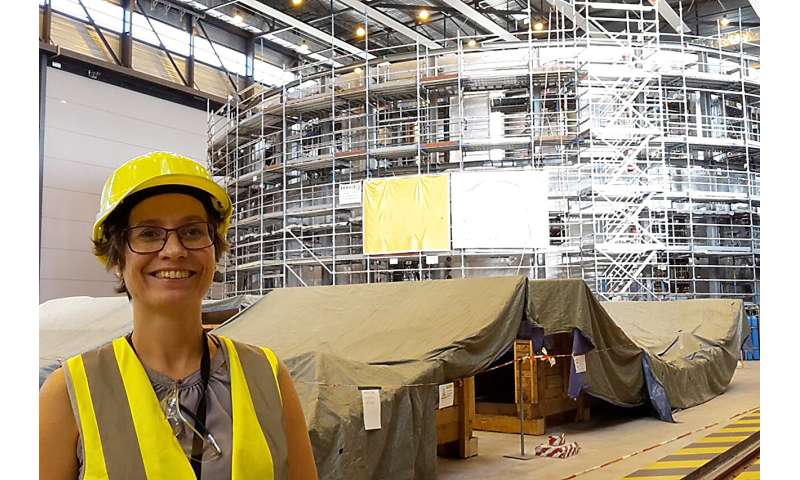William & Mary to lead machine learning efforts for nuclear fusion

Nuclear fusion is a safe, carbon-neutral energy source that could replace current coal and gas power plants. The U.S. government is accelerating progress through a strategy called "Developing a Bold Decadal Vision for Commercial Fusion Energy."
William & Mary is a leading contributor to this vision. In March last year, W&M Associate Professor of Physics Saskia Mordijck attended the dedicated White House Summit in her capacity of vice president of the University Fusion Association. Now, she is a principal investigator on a women-led project focusing on machine learning and AI for fusion, that has been selected for funding by the U.S. Department of Energy through the Fusion Energy Science program.
"Open and FAIR Fusion for Machine Learning Applications" has been allocated nearly $5 million over three years, with William & Mary set to receive $1.3 million. The W&M component includes a summer school as well as workforce participation at all levels—from undergraduate students to postdoctoral fellows and faculty. Pieter Peers, associate professor of computer science, and Cristiano Fanelli, assistant professor of data science, are also involved as senior scientists.
Mordijck, a leading expert on plasma, aims to establish a plenary approach to get W&M students involved.
Collaborators on the project include researchers at University of Wisconsin–Madison, the Massachusetts Institute of Technology, Auburn University and The HDF Group—a non-for-profit corporation specializing in open-source data management.
Nuclear fusion could advance the federal government's goal to reach net-zero emissions by no later than 2050 by providing safe, clean and sustainable energy.
Machine learning has already been applied to nuclear fusion data sets both in the public and the private sector; however, these are not open and accessible, and their neural networks often remain publicly unavailable even after results are published.
Mordijck and her co-investigators will instead adhere to FAIR principles and Open Science best practices, making their datasets findable, accessible, interoperable and reusable.
"The whole group is going to build the first-ever platform for open and fair data in fusion energy research," said Mordijck, who defined this objective as "revolutionary."
Sharing data for open fusion
Nuclear fission releases energy by splitting atoms apart. In nuclear fusion, two atomic nuclei are fused together: They form a single nucleus with a total mass that is less than the sum of the original two, with the leftover mass becoming energy.
In December 2022, net energy gain through controlled fusion was achieved for the first time in history by a team at the National Ignition Facility. However, there are several challenges in making nuclear fusion commercially viable on a large scale, which many experts see as being 30 years away. Fusion reactions take place at a temperature of at least 100 million degrees Celsius (180 million Fahrenheit, or over seven times hotter than the sun's core) and at a superheated state of matter called plasma.
Several plasma confinement strategies are currently being researched to successfully produce energy from fusion, including magnetic fields and inertial fusion energy.
"This is where machine learning comes in," said Mordijck. "You can discover new physics, you can discover new regimes, which could accelerate the path to fusion energy."
AI-driven predictive modelling will be instrumental in optimizing plasma performance, detecting anomalies and monitoring operations.
In order to be shared and used, however, data needs to be accessible and interoperable. "The idea is to set and pioneer some standards," said Mordijck.
This is the reason why the project brought together different universities, with their diverse machines, and an industry partner specializing in data structures. The project team will work with data from tokamaks and stellarators, both of which are approaches that use magnetic fields to contain plasma.
"By having this platform, hopefully others will see a benefit to having data structured in this way and will then develop the workflows to transmit their data there as well," said Mordijck.
Involving universities also means involving students in major developments. William & Mary will lead on the "people" component.
"We've already had some students involved in early work on that topic, and we hope to expand on that," said Mordijck.
Research projects will be focusing on datasets related to magnetic confined plasmas; some students will work on creating the workflows to build datasets, and others will focus on analyzing datasets using machine learning.
Toward nuclear energy justice
As part of the project, for the next three years William & Mary will run a summer school focused on data science and machine learning for fusion energy, to which both W&M and external students will be able to apply.
Subsidized housing will be a major component of the summer program, so to cover as many costs as possible for students.
According to Mordijck, combining a job-oriented subject like data science with physics represents "another way to help diversify who actually gets to talk about fusion energy and who is involved in that research."
Securing environmental justice and providing "clean energy" jobs is part of the federal Justice40 initiative, which aims to deliver 40% of the overall benefits of relevant investments to disadvantaged communities.
"If you look at who has access to clean energy right now, you will find that it is not in poor or minority-majority communities, "said Mordijck. "They will get coal power plants, they will get dirty industry, all the pipelines will run through their neighborhoods."
Mordijck said that an important challenge was making sure that fusion energy could benefit the communities that need it the most.
"I think it requires not just outreach, but community building," she said. "It could range from just knowing that it exists to real engagement, listening and having these communities be active participants in the development of fusion energy."
More information:
C. Rea, S. Mordijck, M. Murillo, et al. (2022). "Fusion," Chapter 9 in Artificial Intelligence for Accelerating Nuclear Applications, Science and Technology (pp. 53—60). Vienna: International Atomic Energy Agency.
Antonella Di Marzio, Senior Research Writer, William & Mary
Provided by William & Mary